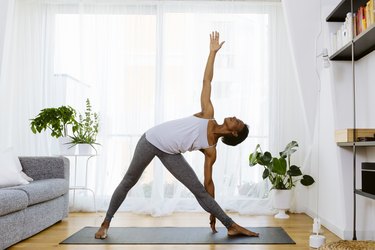
Transitions are an important element of five-paragraph essays, TV shows and, of course, your workouts. But did you know there's a type of yoga that's all about transitions? Enter: Vinyasa yoga.
"Vinyasa yoga is a style of yoga that involves seamlessly stringing together postures and poses and syncing that movement with your breath," Donna Noble, a London-based yoga instructor and founder of Curvesome Yoga, tells LIVESTRONG.com.
Vinyasa is taught at a faster pace than a more gentle practice like Hatha yoga, and in many ways, it can feel like one big dance as you link each movement to your breath. Vinyasa yoga is also a great way to add an aerobic element to your yoga practice without it turning into a full-blown, body-weight HIIT workout.
Read on to learn more about Vinyasa yoga, its benefits and what to expect in your first class, plus a sample Vinyasa flow to try at home.
Related Reading
What Is Vinyasa Yoga?
In Sanskrit, Vinyasa means to place in a special way. "Literally speaking, Vinyasa might be defined as the intentional placing (and ordering) of movements in a sacred way," Noble says. Poses are strung together in a certain way so they blend into one movement.
Think of Vinyasa yoga like a layered cake: It's not the individual ingredients, but the overall product that comes from blending, mixing and whisking the eggs, flour, milk and sugar together. During a Vinyasa yoga class, you don't do one pose, stop and then do another. Instead, "you intentionally yoga flow from one position to the next," Noble says.
You may also hear people refer to Vinyasa yoga as Ashtanga yoga or Ashtanga Vinyasa yoga because Vinyasa yoga was born out of the school of Ashtanga. Just like Vinyasa, Ashtanga yoga also synchronizes your breath to movement, so you inhale while holding a pose and exhale as you transition to another.
However, Ashtanga yoga follows the same sequence of positions for every class, and Vinyasa yoga doesn't. "No two Vinyasa classes are alike because the yoga instructors can put poses together in whatever combination they see fit," Noble says.
The Benefits of Vinyasa Yoga
Vinyasa yoga provides a wealth of benefits, including mental, physical and spiritual, says Quincéy Xavier, a DC-based coach and yoga instructor.
While the studies around Vinyasa yoga are small, they suggest that it can help enhance different aspects of a healthy lifestyle.
It Can Boost Your Mood
While Vinyasa is a faster-paced practice, it offers many of the stress-busting benefits of restorative yoga because it focuses on using your breath to guide you.
"When you learn how to cultivate an awareness of your breath and movement in class, you can take that skillset with you into your everyday life for increased feelings of peace, calm and happiness," Noble says.
For example, in a small September 2014 study in the International Journal of Yoga Therapy, researchers measured the stress levels of 20 college students, as well as their positive and negative feelings, before and after they did eight weeks of twice-weekly Vinyasa yoga classes. By the end of the eight weeks, the students' positive feelings increased and their negative feelings decreased (but the study did not compare the effects of yoga to those of other types of workouts).
It Can Strengthen Your Muscles
What distinguishes Vinyasa yoga from other types of yoga, like Bikram, for example, is the emphasis on the transitions between positions. However, that doesn't mean you won't also be holding positions for a longer period of time — you will!
In fact, most poses in Vinyasa yoga will be held at least once for 30 to 120 seconds. And when you're holding your body in a very specific position for a few seconds, your muscles have to work hard to maintain the shape.
"The longer you hold a position, the greater the muscle breakdown is," says Grayson Wickham, DPT, a certified sports and conditioning specialist (CSCS) and founder of the Movement Vault. And the greater the muscle breakdown, the more muscle growth you'll have after rest and recovery, Wickham says.
In this way, Vinyasa yoga can promote muscle strength and growth. However, if growing visibly larger muscles is your primary goal, then incorporating some strength training into your routine is going to be more effective, Wickham says.
It Can Give You a Good Cardio Workout
While most Vinyasa classes will start and end with Savasana, aka Corpse pose, once you get flowing, you don't stop.
The faster pace of Vinyasa yoga makes it much more challenging and is ideal for a lower-intensity cardiovascular workout, according to an August 2013 study in the Journal of Yoga and Physical Therapy.
If you regularly do cardio, like running, biking and swimming, then Vinyasa yoga probably won't jack up your heart rate as much as you're used to. But, Noble says, "even more advanced athletes will be shocked at how high their heart rates get during a flow."
It Can Improve Your Mobility
"Nearly 90 percent of the people who come into my office with an injury could have prevented that injury with some mobility work," Wickham says. And guess what? Vinyasa yoga counts as mobility work.
"Vinyasa yoga encourages folks to move their joints through their full range of motion, and to develop strength in those positions, which is the perfect recipe for increased mobility," he says.
By increasing your mobility, you can move more freely and reduce your injury risk, Wickham says. Better mobility can also lead to increased body awareness and fewer aches and pains.
It Can Enhance Your Core Stability
"You have to engage your core for almost every single posture in yoga because if you don't, you can risk injuring your lower back," Noble says.
You can expect to do plenty of variations of planks, side bends and twists in Vinyasa yoga, which all work your core muscles. The result of all this core activation is increased core strength.
"Strengthening your core means increased stability, balance, reduced risk of injury and a decrease in lower-back pain," Wickham says.
It May Help You Quit Smoking
In a February 2012 study in the Journal of Women's Health, researchers recruited 55 women undergoing cognitive behavior therapy (CBT) to quit smoking and divided them into two groups: those who would complement CBT with Vinyasa yoga twice a week and those who complement it with a more general health and wellness program.
Results showed that, on average, participants in the yoga group went without smoking longer than those who didn't do yoga. The women in the yoga program also reported lower anxiety and stress levels compared to their peers.
Who Should Try Vinyasa Yoga?
Like a college-level physics class, Vinyasa yoga has a list of prerequisites. You need some understanding of how to do the positions safely and correctly, plus a certain degree of strength, mobility and body awareness.
So unless the class you're looking for specifically indicates that it's beginner-friendly yoga or a "slow flow," Noble says, Vinyasa yoga typically isn't the best style for inexperienced yogis. She recommends yoga newbies take a few Hatha yoga classes to learn the basic poses prior to advancing to Vinyasa.
But don't let the pre-work scare you. According to Xavier, Vinyasa yoga is a great option for anyone with a sports background who's looking to add a dose of mindful movement to their workout routine. It's also a great option for anyone who is interested in improving their cardiovascular capacity, strength and muscle endurance.
Related Reading
What to Expect at Your First Vinyasa Class
If you hop into any Vinyasa class, you might feel a little overwhelmed, especially if you've never taken any other yoga class. Fortunately, Vinyasa classes follow the same general structure.
You'll start the class with a few minutes of breathing exercises — typically in the Savasana position. This grounding portion of class is intended to help you reconnect with your breath, which you'll rely on throughout class to support your transitions. Next, you'll warm up your muscles with movements, like Cat-Cow and Downward Facing Dog, before moving into the bulk of class.
From here, your instructor will slowly guide you through the first sequence of poses, providing form tips and cues along the way. Then, you'll typically repeat that sequence once or twice more at a faster pace. Next, you'll repeat this same format with a second sequence.
Most classes will have you move through two to four sequences. When all sequences are complete, you'll cool down with a final Savasana.
What to Bring and Wear to Vinyasa Yoga
Unless a class specifically indicates that it's taught in a heated room, Vinyasa yoga is not hot yoga. But keep in mind that you'll be moving from start to finish, so expect to sweat. Noble recommends bringing a water bottle and towel if your studio does not provide them (or keeping both nearby if you're practicing at home).
As for your wardrobe, any breathable, moisture-wicking workout clothing that allows you to bend, twist and jump in any which way goes. That means something stretchy and form-fitting like workout leggings, a sports bra, shorts and a tank, or shorts with built-in spandex and a breathable top.
How to Find a Vinyasa Class Near You
A simple web search can help you find Vinyasa yoga near you. If a few studios pop up, take time to read through their class descriptions and reviews and scroll through their Instagram page. This will increase the chances that you pick a studio with the vibes that best match your personality and fitness needs.
That said, Noble says, "even at the same studio two instructors can be incredibly different." If your first class and instructor are a miss, give it another shot with a different instructor — they could be a hit.
Plenty of popular Vinyasa yoga studios and apps offer online classes for free or at a reduced monthly subscription price, including:
If the last thing you want is to commit to yet another membership, head to YouTube. Popular Vinyasa yoga YouTube channels include Yoga With Tim, Samyak Yoga, Yoga With Adriene, Jessamyn Stanley and Sadie Nardini.
Another option is to follow your favorite Vinyasa yoga instructors on Instagram. Recently, many yoga and fitness instructors are offering classes through their personal Instagram pages. A few fan-favorite instructors are Briana Casey, Sarah Bess Hutchinson and Flow Jo.
A 15-Minute Beginner Vinyasa Flow to Try
Below, Briana Casey, a Los Angeles-based yoga instructor, shares a 10- to 15-minute sample Vinyasa flow.
Repeat the sequence below three times. One the first round, hold each pose for 3 to 5 breaths. During the second and third rounds, match breath to movement.
Move 1: Mountain Pose (Tadasana)

- With your big toes touching and heels slightly apart, find equal balance on both feet.
- Engage your thighs.
- Bring your arms straight up over head and relax your shoulders down and back.
Move 2: Baby Back Bend
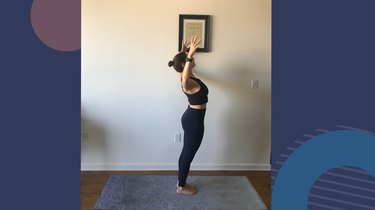
- From Mountain pose, bend your elbows to 90-degree angles and keep them in line with your shoulders.
- Push your hips forward slightly.
- Lift your chest toward the ceiling.
Move 3: Mountain Pose (Tadasana)
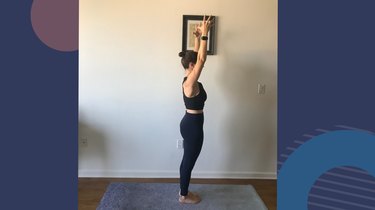
- Return your arms straight up over head and relax your shoulders down and back.
- Tuck your tailbone and pull your pinky fingers in toward your midline.
Move 4: Forward Fold (Uttanasana)
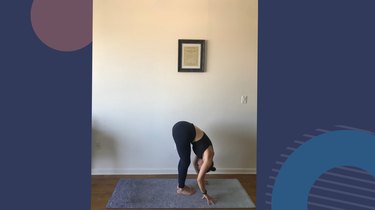
- From Mountain pose, pull your hands through heart center and release them toward the ground.
- Bend at your hips and reach your hands to the ground. If you're able to, wrap your hands around your ankles or touch the floor in front of you with your fingertips.
Move 5: Halfway Lift (Ardha Uttanasana)
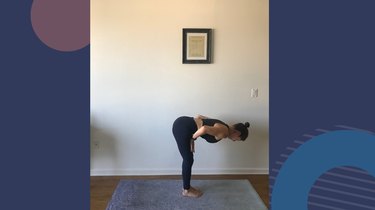
- Maintaining a tight core and flat back, bring your hands to your shins or thighs.
- Think about creating length in your spine.
- Shift your weight slightly forward and send your gaze about six inches in front of your nose.
Move 6: High to Low Plank (Chaturanga)

- Find a high plank position with your shoulders directly over your wrists, legs extended behind you and your glutes tight.
- Bend your elbows somewhere between 45 and 90 degrees, lowering your chest toward the floor so it's hovering a few inches above the ground.
Move 7: Upward Facing Dog (Urdhva Mukha Svanasana)
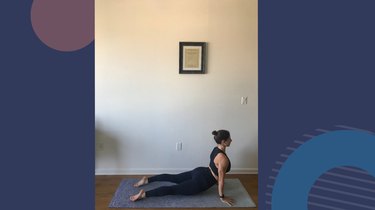
- From a low plank, straighten your arms and untuck your toes.
- Pull your chest slightly through your arms, opening the chest and shoulders.
Move 8: Downward Facing Dog (Adho Mukha Svanasana)
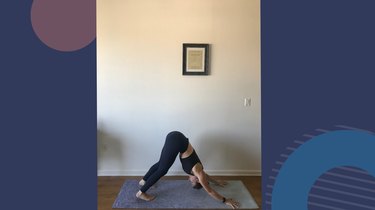
- From Upward Facing Dog, re-tuck your toes and send your hips up and back, bringing your chest toward your thighs.
- Push through your thumbs and pointer fingers.